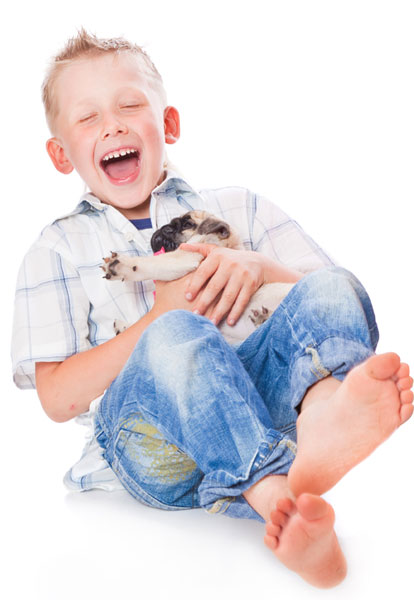If you see this icon in a fact sheet summary you may be dealing with a life threatening issue. Consult a veterinarian immediately.
Use our webform to ask a question or book an appointment

OSTEOARTHRITIS
Osteoarthritis (also called degenerative joint disease or DJD in veterinary medicine) is a progressive deterioration within the joints, where degeneration of the cartilage lining the ends of bones, changes of the underlying bone at the joints, and changes of the joint capsule that secretes the joint fluid leads to constant and often severe pain.
Osteoarthritis affects both dogs and cats and arthritic changes are seen in most older patients at some stage in their lives, but the disease can also affect young animals if associated with inherited or growth disorders such as hip dysplasia or patella luxation, or sometimes as a result of trauma such as a fracture, dislocation or ligament injury.
In older patients long term exercise and simple ageing are usually the cause. Working dogs and overweight pets are more likely to suffer osteoarthritis at a younger age. Other possible causes are immune-mediated arthritis — rheumatoid arthritis — infectious arthritis or a tumour.
SEVERITY: Moderate to Severe. All dogs with arthritis will be in pain. In advanced cases pain will be chronic and debilitating. See treatment.
Intermittent lameness that slowly becomes more frequent and severe is the usual sign. Stiff movement, difficulty rising and difficulty going up and down stairs are also common signs. Exercise can result in increased lameness, as can cold weather and lying down for long periods. As these signs develop very gradually it is often easy to accept them as signs of old age, rather than as signs of your pet suffering the treatable pain associated with osteoarthritis.
Because arthritis usually develops so gradually, many pet parents find it hard to remember how their pet was before arthritis set in. Your pet is definitely in pain if they are showing signs of limping, are sore after exercise, get up or down gingerly, or can’t or won’t climb steps. The pain is constant and our pets very stoic, so these signs are the only way to assess how painful the arthritis is. The pain should be treated. Response to medication in most cases is excellent, and can give an older pet a new lease on life.
X-rays are often taken, and in some cases analysis of fluid from within a joint or biopsy of tissues within the joint may be needed. For the most part though, a diagnosis can be made from a simple examination and our knowledge of the history of your pet.
The degeneration within the joint is permanent and will continue to develop, so treatment of osteoarthritis is primarily palliative, i.e., designed to relieve the clinical signs with painkillers, and in some cases slow the progression of osteoarthritis.
Two types of medical treatment exist. Straight pain relief is available in oral tablets or drop form. This type of medication gives very good results but needs daily or twice daily dosing.
A second type of medication frequently used is Pentosan, either via a course of 4 injections given at 7 day intervals or by capsules. Improvement with this treatment is usually gradual over the 4 weeks, so additional pain relief may also be given for the first 1-2 weeks.
These injections treat the pain of osteoarthritis, but they also slow the ongoing degeneration by protecting the cartilage, and improving the quality and amount of joint fluid in all the joints of the body. An excellent response in usually seen with this medication. Duration of effect is variable, often related to the initial severity of signs.
Further treatment is tailored to the individual; some patients may be extremely comfortable for 6-12 months before requiring a repeat course of injections, others may deteriorate after a couple of months and require a single injection to be given every 1-2 months. Some animals need ongoing pain relief as well as the injections.
Sometimes when the diagnosis of osteoarthritis is made an underlying cause is also diagnosed, such as hip dysplasia, cruciate ligament rupture or patella instability, which may need surgical treatment. Surgical options can range from the relatively routine (CCL) to advanced solutions such as custom made implants to fully replace arthritic joints.
Diet plays a large part in ongoing treatment. There are a number of ‘joint support’ diets available, all of which contain elements which can help reduce the effects of the disease. These can be green-lipped mussels, traditionally used in treatment of arthritis for the past 25 years and/or glycosaminoglycans, a vital joint nutrient. These formulations not only promote joint health they deliver a nutritionally balanced diet for overall patient well-being. One of the most important things you can do for a pet suffering from arthritis is to not overfeed — keep them lean.
Being overweight puts added pressure on joints, increasing pain and degeneration. It’s very easy for an arthritic patient to become overweight as their activity levels fall due to the pain. Overweight pets need to be on strict diets — please talk to us for advice about this.
Activity should be restricted to a level that doesn’t aggravate the condition. If your pet is sore after a walk, try shorter walks. If chasing the ball makes things worse, play for less time, or not at all. Swimming is an excellent form of exercise as it is non-weight bearing and puts less stress on joints, but cold aggravates osteoarthritis so a warm pool is needed.
Cold should be avoided as much as possible. Arthritis will always be worse in winter. If your pet is allowed to sleep inside this will help. Try to minimise exposure to cold by providing thick warm bedding, ideally not on concrete), a warm sheltered area and consider a warm dog coat for winter.
MORE DISEASES OF DOGS
DOGS: ADVICE FOR EMERGENCIES


